Feed aggregator
Review: Tideborn by Eliza Chan
 Buy Tideborn
OFFICIAL AUTHOR BIO: Eliza Chan is a Scottish–born Chinese–diaspora author who “writes about East Asian mythology, British folklore and reclaiming the dragon lady, but preferably all three at once”. Eliza’s work has been published in The Dark, Podcastle, Fantasy Magazine and The Best of British Fantasy, and her non-fiction has appeared on Tor.com. She lives in the north of England with her partner and young child.
Buy Tideborn
OFFICIAL AUTHOR BIO: Eliza Chan is a Scottish–born Chinese–diaspora author who “writes about East Asian mythology, British folklore and reclaiming the dragon lady, but preferably all three at once”. Eliza’s work has been published in The Dark, Podcastle, Fantasy Magazine and The Best of British Fantasy, and her non-fiction has appeared on Tor.com. She lives in the north of England with her partner and young child.FORMAT/INFO: Tideborn will publish on March 25th, 2024 from Orbit Books. It is 384 pages long and will be published in hardcover, ebook, and audiobook formats
OVERVIEW/ANALYSIS: A selfless act may have saved the citizens of Tiankawi, but the city is not out of danger yet. A deadly force is heading towards the city, and this time, it may be unstoppable. Nami the water dragon must lead an expedition out into the open ocean in an attempt to stop the disaster before it's too late. But dangers lurk within the city as well. Tensions between fathomfolk and humans are even worse than before. If Mira the half-siren doesn't find a way to unite the people, the city may tear itself apart from within before any outside force can destroy it.
Tideborn is a bit of a muddled mess as it tries to make sense of a city crippled by prejudice as an impending disaster approaches. Smartly, the magic that saved the city from destruction at the end of Fathomfolk did not also magically solve racism overnight; if anything it made it worse, causing even more fracturing in a populace grappling with dramatic change. But now nearly all of the protagonists' victories are tied to solving racism in some way, and they have to do it in the space of one book.
The author has mixed success in portraying effective resolution of these tensions. Ironically, Nami the water dragon's storyline, which I was less interested in overall, has perhaps the most realistic storyline. She is sent on a mission on a boat with roughly a dozen other people, both human and fathomfolk. Within this microcosm is a range of prejudices and acceptance; in order to achieve her mission, Nami has to find a way to get her crew to set aside their fears and prejudices about each other, while also dealing with her own insecurities. It's not an easy task, but winning the hearts and minds of a handful of people is much easier than that of a whole city.
The rest of the characters are left to deal with the political turmoil in Tiankawi, and this happens less effectively. On the one hand, this makes sense. You can't make the population of an entire city set aside their individual fears and hatreds with the snap of your fingers. But that also means that it's hard to get a satisfying sense of victory. Mira and her allies can triumph over some figureheads, but they really haven't solved the root of the problem by the end of the story. It leads to a somewhat messy finale as none of these internal problems are really resolved, even if the biggest threat was eliminated.
The lack of a cohesive end goal is, at the end of the day, what causes this story to feel a bit scattered. Nami has a clear goal in her mission, but Mira's is a bit more nebulous. She is basically simply trying to hold the city together long enough for either Nami to succeed or for the city to be destroyed. The result is Mira is dealing with several different forces trying to undercut both her and any attempts at peace, leaving her fighting enemies off on all sides. Cordelia the sea-witch, on the other hand, has an even less clear goal, turning her aims this way and that in pursuit of her personal whims.
(And yes, Nami's toxic boyfriend is still around, and yes, you will still want to drop kick him into the sun.)
CONCLUSION: It's hard to sum up my final thoughts on Tideborn. On the one hand, I really appreciate the themes the author is grappling with. But because these themes don't have an easy answer, there's no clear resolution at the end of the day. Yes, some villains are thwarted, but as the story shows, that doesn't dissolve the beliefs of their followers. While I do enjoy the world the author created and the characters that inhabit it, the city at the heart of Tideborn is perhaps too realistically riddled with prejudice for the duology to have a satisfying resolution.
Comment on Worldbuilding Articles: Reader Poll (2025 Edition) by Allan
1. Branch Affinities
2. Essentia Capacity
3. The Board
4. Sigi Recycling
Just a Few More Hours…
…to get my upcoming class, “Craft in the 21st Century,” for the early bird price. Right now, it’s $200. After it goes live tomorrow, it’ll be $250. Hurry on over if you want to refresh your writing for the 2020s. Click here to get more information and order the class.
We’re also offering some coaching on publishing your work.
We’ve been conducting a writer’s block course, and in the webinar, we learned that one thing which actually blocks writers in 2025 is the learning curve for indie publishing. People get stuck at various different places, so we can’t just do a simple do-this, do-that course anymore. (It was possible ten years ago; isn’t possible now)
So Dean wants to help as many folks as he can. But he can only do it one at a time. Therefore, for 3 months, he’ll help a few people get started from wherever they’re stalled. Then, if that works, he’ll do it again for a different group.
If you’re interested, check out this post: https://deanwesleysmith.com/coaching-getting-your-stuff-out/
Alternate Londons, the Future of Lotteries, and Colony Ships: January-February Print Magazines
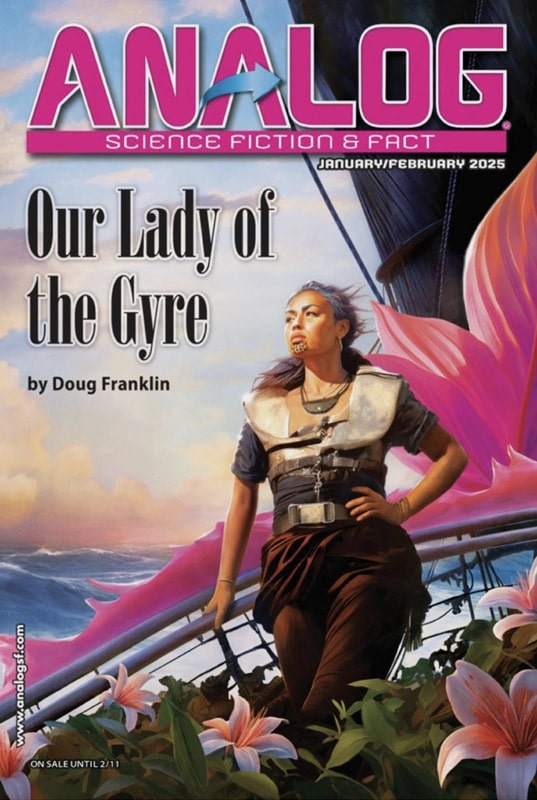
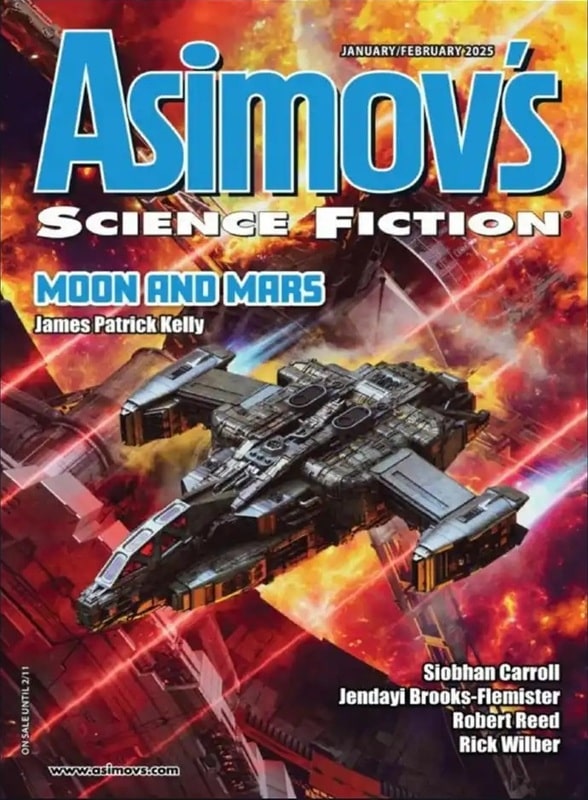
January-February 2025 issues of Analog Science Fiction & Fact and Asimov’s Science
Fiction. Cover art by Tomislav Tikulin (for “Our Lady of the Gyre”) and Shutterstock
Still no sign of the next issue of The Magazine of Fantasy & Science Fiction, which is disheartening. That leaves us with only two issues published last year (Winter 2024 and Summer 2024), and no hint when the next one might arrive. I’m hearing rumors that the magazine has been sold, but I’ve been unable to confirm that, so for now it’s just gossip.
But we’ve got issues of Asimov’s Science Fiction and Analog Science Fiction & Fact in hand, and they’re just as enticing as usual, with contributions from John Shirley, Sean McMullen, Mark W. Teidemann, Steve Rasnic Tem, Paul Di Filippo, Sakinah Hofler, James Van Pelt, James Patrick Kelly, Siobhan Carroll, Robert Reed, Faith Merino, Matthew Kressel, Rick Wilber, Jane Yolen, Kendall Evans, and many more.
The issues contain a new Great Ship tale by Robert Reed, a new Unsettled Worlds story by Siobhan Carroll (which Sam Tomaino calls a “suspenseful, exciting tale”), a new novelette “Rejuve Blues” from John Shirley (which Victoria Silverwolf labels “a suspenseful crime story and psychological study”), and the last installment in James Patrick Kelly’s trio of stories about Marishka Volochkova, “Moon and Mars,” which Sam proclaims is “probably another Nebula nominee.”
Victoria Silverwolf at Tangent Online enjoyed in the latest Analog.
“Our Lady of the Gyre” by Doug Franklin mostly takes place aboard a sea vessel that fights excess carbon dioxide in the atmosphere via bioengineered diatoms. The protagonist, who communicates with an artificial intelligence orbiting the Earth, takes two young people on his ship and faces a dangerous storm… a very dense work of fiction that requires careful reading. At first, it is difficult to tell what’s happening or what this future world is like, but patient readers will be rewarded with a vivid and imaginative tale with appealing characters.
The novelette “Rejuve Blues” by John Shirley features an elderly couple who win a lottery that offers them the chance to be young again. The man runs into trouble with criminals, while the woman, thinking he has left her, returns to her former activity as a fighter against the Taliban. The author creates a complex and convincing future that is neither utopian nor dystopian… a suspenseful crime story and psychological study.
The main character in “Go Your Own Way” by Chris Barnham accidentally discovers a way to travel into alternate versions of London, some very similar to the familiar one and others wildly different. He falls in love in one of these parallel worlds, but the arrival of an alternate version of himself causes complications. The plot is that of the eternal triangle, in which two of the people involved are the same person. (One might call it an isosceles triangle.) The various parallel Londons are described only briefly, and are far more interesting than the love story…
In the novelette “Prince of Spirals” by Sean McMullen, conspirators kidnap a forensic anthropologist and force him to study samples from the skeletons of two bodies thought to be the so-called Princes in the Tower, heirs to King Edward IV of England… The motive is to determine if either Prince survived to have descendants, giving members of the conspiracy a claim to the throne… This is a suspenseful crime story, with intriguing speculative technology and an interesting look at the techniques used by forensic anthropologists.
At first, “Quest of the Sette Comuni” by Paul Di Filippo seems like pure fantasy, as a female satyr and a golem set out to rescue a princess from a wizard, in order to free their master from his imprisonment by a sea-dwelling queen. It soon becomes clear that the golem is actually a machine and the other characters are the result of advanced biotechnology. The setting is richly imagined, from an underwater Venice inhabited by amphibious humans to an antagonist who has made himself resemble the Jabberwock from Lewis Carroll’s famous nonsense poem. Although not a comedy, the story has sufficient amount of subtle wit to draw the reader into its colorful world.
The magazine concludes with the novella “Apartment Wars” by Vera Brook. The setting is Poland in 1979. The widow of a scientist faces the possibility that she will be forced out of her relatively large apartment by the government because she lives alone. She expects her daughter and son-in-law to arrive soon as permanent guests, justifying her need for the place, but time is running out. Meanwhile, the abusive boyfriend of a neighbor threatens to expose her situation to the authorities… The situation takes a dramatic turn when the widow discovers an extraordinary device built by her husband.
Read Victoria’s complete review here.
The new Asimov’s is thoughtfully reviewed by Mina at Tangent Online. Here’s a sample.
“In the Splinterlands the Crows Fly Blind” by Siobhan Carroll takes patience to read. The world building is complex and initially confusing. The protagonist, Charlie, sets off to find his missing brother, Gabe, as well as Gabe’s girlfriend. There are some groovy invented words like Universe-shard, atmotech, Crowmind, Crowdogs and Vestigium — along with words from what seems to be a Cree dialect — they do eventually all make sense. Charlie finds himself a hero as he saves his fragment of world from destruction by the carelessness of “some rich guy stepping on butterflies.” Worth persisting.
“Five Hundred KPH Toward Heaven” by Matthew Kressel is set just after the heyday of lifts into space, reminiscent of train travel. They are being replaced by much faster, cheaper ships. In a final ascent party, Terese reminisces with other lift pilots and ponders on what is being lost — a sense of wonder and a sense of connection — “sometimes there’s benefits to going slow.”
“Shadow of Shadows” by Frank Ward is a pleasure to read because, once you reach the end, the title hits you with its full poignancy. This reader appreciates when an author does this so well. A washed-up research physicist stands at the threshold of finally finding proof for his theory of a “Many Worlds Interpretation.” The proof of alternate universes is, however, not without pain. A tale that explores not just quantum theory but also its emotional repercussions. I would read this twice.
The tension build-up in “What the Frog’s Eye Tells the Frog’s Brain” by Beston Barnett is incredible. One can only say: bravo! In this story, a desperate scientist, being interrogated and tortured by an AI courageously sets out to trick it into shutting down. The references to Linux, Hexspeak and ASCII are very satisfying for this linguist, for AI does indeed have its own language.
“My Biggest Fan” by Faith Merino is a creepy and ultimately sad tale. The narrator grows up seeing the same woman and hearing the same tune at regular intervals; but she is always a different age. She leaves him notes signed “your biggest fan.” When he finally understands why their trajectories keep overlapping, it’s tool late: they have become each other’s hell, as Sartre would say. Quantum particles meet stalker meet Greek tragedy.
In “Moon and Mars” by James Patrick Kelly, Moon-settler Mariska is part of the crew on the Natividad, a colonists’ ship she has joined to be with her Martian boyfriend, Elan. It soon becomes apparent that those with vested interests in the anti-matter that will power the ship through a wormhole to the Destination planet on the other side are trying to stop the mission. Mariska, her mother and Elan are all part of a group determined to take off early before the mission can be stopped. The race against time is gripping…. A great read.
Read Mina’s full review here.
Here’s all the details on the latest SF print mags.
[Click the images for bigger versions.]
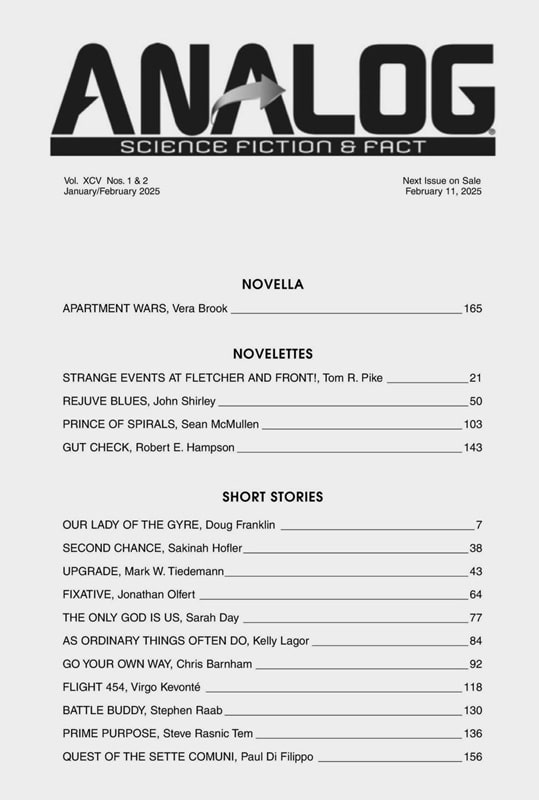
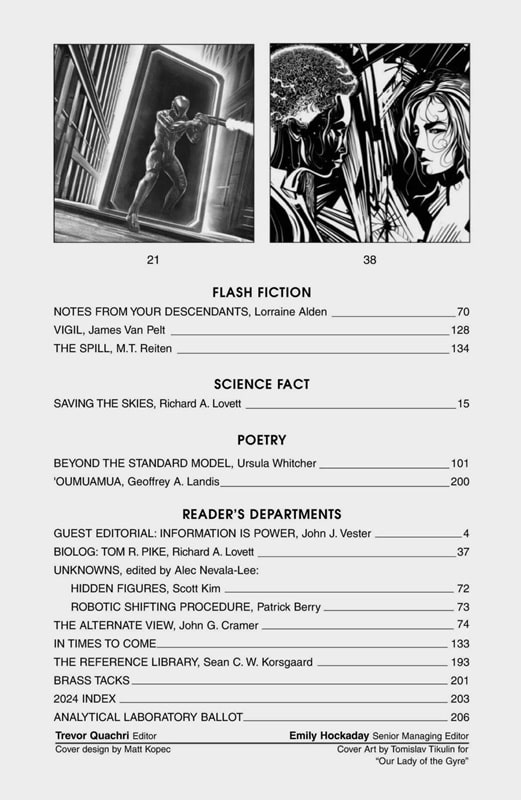
Contents of the January-February 2025 issue of Analog Science Fiction
Editor Trevor Quachri gives us a tantalizing summary of the current issue online, as usual. Sadly, I didn’t think to grab a copy before the latest issues dropped. Next time.
Here’s the full TOC.
Novella
“Apartment Wars” by Vera Brook
Novelettes
“Strange Events at Fletcher and Front!” by Tom R. Pike
“Rejuve Blues” by John Shirley
“Prince of Spirals” by Sean McMullen
“Gut Check” by Robert E. Hampson
Short Stories
“Our Lady of the Gyre” by Doug Franklin
“Second Chance” by Sakinah Hofler
“Upgrade” by Mark W. Teidemann
“Fixative” by Jonathan Olfert
“The Only God is Us” by Sarah Day
“As Ordinary Things Often Do” by Kelly Lagor
“Go Your Own Way” by Chris Barnham
“Flight 454” by Virgo Kevonté
“Battle Buddy” by Stephen Raab
“Prime Purpose” by Steve Rasnic Tem
“Quest of the Sette Comuni” by Paul Di Filippo
Flash Fiction
“Notes From Your Descendants” by Lorraine Alden
“Vigil” by James Van Pelt
“The Spill” by M.T. Reiten
Science Fact
Saving the Skies: How One Small City in Arizona is Pointing the Way to a Better (Darker) Way, by Richard A. Lovett
Poetry
Beyond the Standard Model by Ursula Whitcher
‘Oumuamua by Geoffrey A. Landis
Reader’s Departments
Guest Editorial: Information is Power by John J. Vester
Biolog: Tom R. Pike by Richard A. Lovett
Unknowns, edited by Alec Nevala-Lee:
Hidden Figures by Scott Kim
Robotic Shifting Procedure by Patrick Berry
The Alternate View by John G. Cramer
In Times to Come
The Reference Library by Sean C.W. Korsgaard
Brass Tacks
2024 Index
Upcoming Events by Anthony Lewis
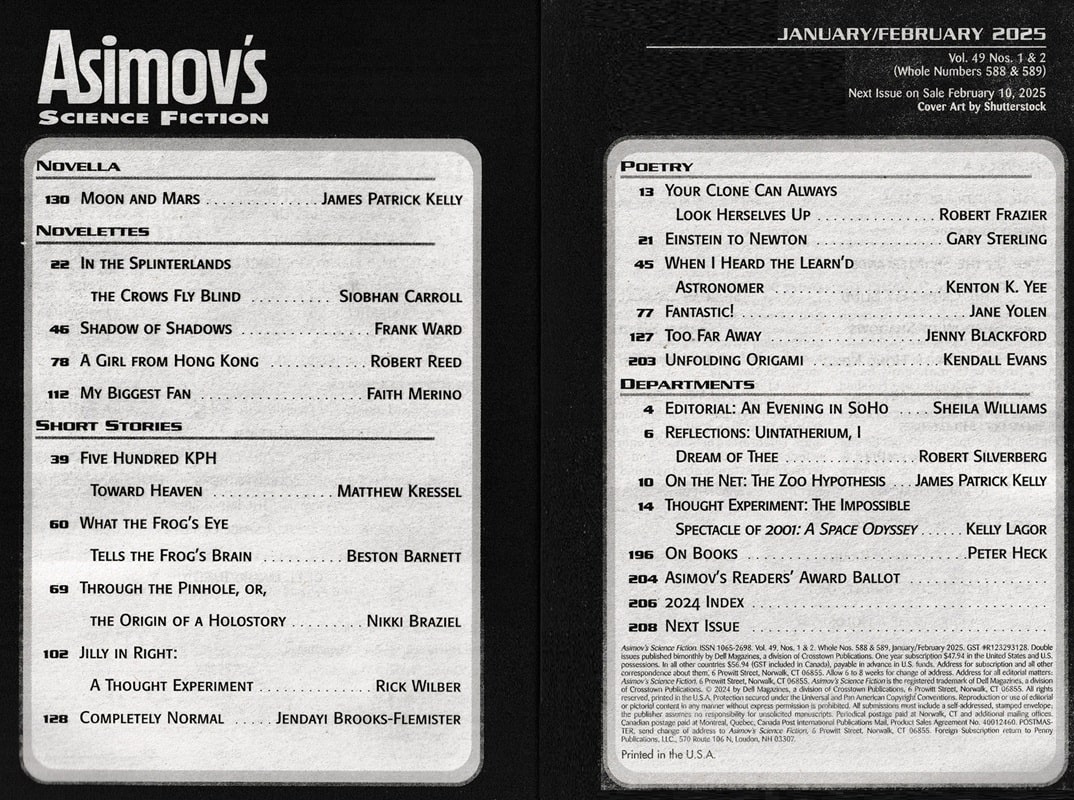 Contents of the January-February 2025 issue of Asimov’s Science Fiction
Asimov’s Science Fiction
Contents of the January-February 2025 issue of Asimov’s Science Fiction
Asimov’s Science Fiction
Sheila Williams provides a handy summary of the latest issue of Asimov’s at the website. But I missed it this month. Next time I’ll remember before it’s gone.
Here’s the complete Table of Contents.
Novella
“Moon and Mars” by James Patrick Kelly
Novelettes
“In the Splinterlands, the Crows Fly Blind” by Siobhan Carroll
“Shadow of Shadows” by Frank Ward
“A Girl from Hong Kong” by Robert Reed
“My Biggest Fan” by Faith Merino
Short Stories
“Five Hundred KPH Toward Heaven” by Matthew Kressel
“What the Frog’s Eye Tells the Frog’s Brain” by Beston Barnett
“Through the Pinhole, Or, the Origin of a Holostory” by Nikki Braziel
“Jilly in Right: A Thought Experiment” by Rick Wilber
“Completely Normal” by Jendayi Brooks-Flemister
Poetry
Your Clone Can Always Look Herselves Up by Robert Frazier
Einstein to Newton by Gary Sterling
When I Heard the Learn’d Astronomer by Kenton K. Yee
Fantastic! by Jane Yolen
Too Far Away by Jenny Blackford
Unfolding Origami by Kendall Evans
Departments
Editorial: An Evening in SoHo by Sheila Williams
Reflections: Uintatherium, I Dream of Thee by Robert Silverberg
On the Net: The Zoo Hypothesis by James Patrick Kelly
Thought Experiment: The Impossible Spectacle of 2001: A Space Odyssey by Kelly Lagor
On Books by Peter Heck
Asimov’s Readers’ Award Ballot
2024 Index
Next Issue
Analog, Asimov’s Science Fiction and The Magazine of Fantasy & Science Fiction are available wherever magazines are sold, and at various online outlets. Buy single issues and subscriptions at the links below.
Asimov’s Science Fiction (208 pages, $8.99 per issue, one year sub $47.97 in the US) — edited by Sheila Williams
Analog Science Fiction and Fact (208 pages, $8.99 per issue, one year sub $47.97 in the US) — edited by Trevor Quachri
The Magazine of Fantasy & Science Fiction (256 pages, $10.99 per issue, one year sub $65.94 in the US) — edited by Sheree Renée Thomas
The January-February issues of Asimov’s and Analog were on sale until February 11. See our coverage of the November-December issues here, and all our recent magazine coverage here.
Comment on Worldbuilding Articles: Reader Poll (2025 Edition) by Randall
Truly looking forward to the third book. In the meantime, the three below are my favored topics of coverage.
1.) Branch Affinities
2.) Sigl Recycling
3.) The Board
While there are others I want to include mentioned by others in the comments, I feel those may be plot points meant to be explored as the books reveal them.
Comment on Worldbuilding Articles: Reader Poll (2025 Edition) by Dawn
Sigl fashion
Attunement
Essentia Capacity
Comment on THE CHAIN OF EYES – Tainted Cabal book 2 – news by Marcus
Dead series?
Comment on Worldbuilding Articles: Reader Poll (2025 Edition) by Justin Gasal
Sigle Recycling
Attunement
Sigle Fashion
Comment on Worldbuilding Articles: Reader Poll (2025 Edition) by Jim Sackman
I am most interested first in closing out knowledge of essentia and sigils.
After that, the structure of the drucrafting world more broadly.
So my order would be:
1 – Essentia Capacity
2 – Attunement
3 – Branch Affinities
4 – Sigl Recycling
5 – Country Affinities
6 – The Board
7 – Corporations
What a Croc, Part III
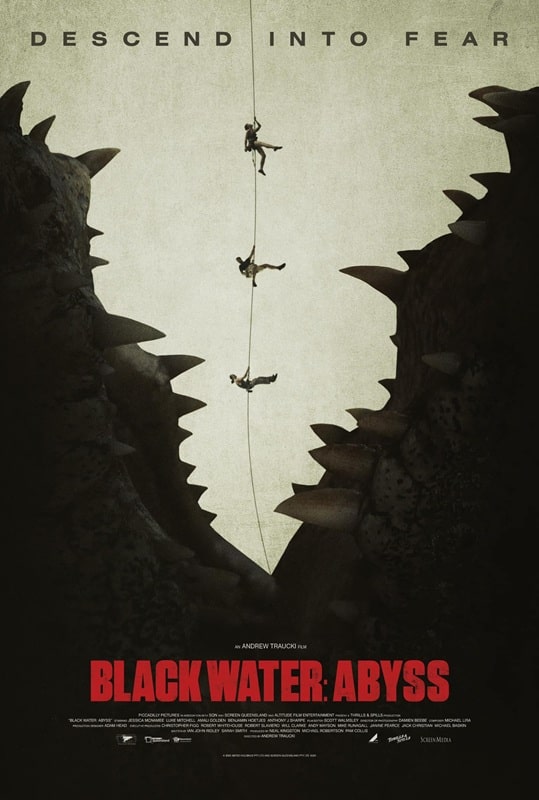 Black Water: Abyss (Altitude Film Entertainment, July 10, 2020)
Black Water: Abyss (Altitude Film Entertainment, July 10, 2020)
My next watch-a-thon is a favorite genre: crocs and gators. Unfortunately, this means the pickings are a bit slim, as I’ve already seen most of them, but I’ve managed to dig up 15 so far (supplemented with a Gila Monster and a couple of Komodos), and I’m sure the intended list of 20 will materialize as streaming services start suggesting titles.
What a Croc #14: Black Water: Abyss (2020) CrackleCroc or gator? Crocodile!
Real or faker? Some pretty great CG.
Any good? I do like me an Aussie croc flick, and this is one of them. The premise is simple: stick some folks in a cave, flood it, trap them, let loose a big croc. The spaces are tight, the tension is taut, and the croc has the good sense to eat the cast in order of character development.*
There’s a bit of relationship drama in the mix between meals, but at the end of the day it’s just a murky cocktail of Rogue and The Decent, but doesn’t come close to being as good as either. Still, I didn’t hate it, and it was well produced, so I’ll grade it a little higher.
7/10
*Now where have I seen that poster design before…?


Lake Placid: The Final Chapter (Syfy, September 29, 2012) and Rollergator (RiffTrax, 1996)
Croc or gator? Alligator(s)!
Real or faker? All terrible CG.
Any good? I still have fond memories of the first time I watched Lake Placid — I was totally unprepared for the all round brilliance of it, from the writing and the cast to the effects and direction. Sadly, each successive sequel has been horrendous, and this one, the incorrectly named ‘Final Chapter’ is the penultimate nail in the coffin.*
As you can tell from the ‘quality’ poster, the story is trite, the characters uninteresting and the effects garbage — the only redeeming features might be Robert England (hamming it up in another gator flick), and Yancy Butler (wasted here as she reprises her role as a two-pack-a-day-voiced rogue ranger). The most egregious aspect of this one though, is the directing and editing. There’s only one director who can get away with that many crash zooms, and his name is Sam Raimi.
Raimi did not direct this.
4/10
*I just discovered there are actually TWO more Lake Placid films after this one. Not that it makes this any easier.
What a Croc #16: Rollergator (1996) TubiCroc or gator? Gator. Small. Purple.
Real or faker? A hand puppet.
Any good? I tried to find the original version of this, but had to settle for the Rifftrax version. Shocking admission: I don’t find Rifftrax particularly funny (not a huge fan of MST3K either) and they just paved the way for stuff like CinemaSins and every other armchair critic who thinks they’re funny. I am fully aware of the staggering hypocrisy of this statement, but there you go.
Anyway, in this film a roller skating woman meets a small, jive talking gator and tries to get him out of the carnival and back to the swamp. Presumably written by a third-grader, it’s utter crap. Not even funny or surreal enough to be a guilty pleasure — just a miserable, miserable slog.
1/10
 Mega Shark vs. Crocosaurus (The Asylum, December 21, 2010)
What a Croc #17: Mega Shark vs. Crocosaurus (2010) YouTube
Mega Shark vs. Crocosaurus (The Asylum, December 21, 2010)
What a Croc #17: Mega Shark vs. Crocosaurus (2010) YouTube
Croc or gator? Croc. Osaurus.
Real or faker? Rubbish CG.
Any good? You know what the answer is going to be, so let’s just cut to the chase. Robert Picardo is a fine actor, he voiced the male, culturally-obsessed alien in Joe Dante’s Explorers and I love him for that. He’s also good in everything else, but I guess he needed a new deck, because he’s in this.
Gary Stretch is also in this. British boxing fans may remember the name, the rest of you will just know him as a punching bag-faced enigma with the looks of a leading man and the mystery of a Swiffer. Sarah Lieving stars opposite him as a potentially badass special investigator who is relegated to scowling boobily at the rest of the cast while flying a pretend helicopter.
The story is rote, the direction and editing are dull and the effects are tragic. The titular creatures (especially the giant croc) are rendered in spectacular blur-o-vision, unhindered by weight or physics. I feel neither joy nor despair at having watched this film, I’m just languishing in a limbo populated by cookie cutters, tight vests and pixels.
4/10


Croczilla (Beijing Enlight Pictures, 2012) and Crocodile (Lions Gate, August 26, 2000)
Croc or gator? Crocodile. Big boi.
Real or faker? Fairly decent CG (in parts).
Any good? I started watching this one quite early on in the watch-a-thon, and thought it had promise, so saved it to end on a high note. It is indeed fun, however, I would sorely love to see a subtitled version, as the English dubbing on this Chinese movie is horrendous.
Promoted as China’s ‘first monster movie’, a claim that has been made on several of the films I’ve watched from China, Croczilla is meant to be a tongue-in-cheek flick. For this reason, the actors ham it up to the level of cartoon characters, and the English V.O. artists were apparently told to do the same, because the dubbing is ear-splittingly intolerable, especially the voice of Barbie Hsu’s character, which threatened to shatter every window in the house.
Aside from the audio hell, it’s a jolly romp, with a 36 ft croc on the rampage in Hangzhou, its belly full of Yuan (about a million worth, or 100,000 Euros as the shrill dubbing informs us). The cast is likeable (although the gangsters are a trifle over the top), and the croc itself is a nice bit of CG. It’s a great model, and for the most part animated well, but some of the interactions with its environment weren’t great. Overall, I enjoyed it, and that’s what matters, so there.
7/10
What a Croc #19: Crocodile (2000) CrackleCroc or gator? Crocodile.
Real or faker? Some OK animatronics and rubbish CG.
Any good? Apparently, when I said Eaten Alive was the only Tobe Hooper film I hadn’t seen, I had forgotten about this one — and I wish it had remained forgotten. I was initially excited when I saw Hooper’s name, doubly so when I saw the effects were done by Nicotero and Berger, but it seems there was no budget for effects and Hooper couldn’t give two shits about the film.
Nobody brings anything fresh to the production, it’s the same tired old story of unlikeable frat kids getting drunk and horny in a swamp, and the only reason to watch is to see how they get dispatched. Unfortunately, save for a couple of fun shots of folks sliding down a gullet, it’s all a bit ham-fisted, and the CG croc suffers from the same weightlessness as all the other low-budget beasts of the era. A shame.
5/10
 Crocodile 2: Death Swamp (Nu Image Films, August 1, 2002)
What a Croc #20: Crocodile 2: Death Swamp (2002) Crackle
Crocodile 2: Death Swamp (Nu Image Films, August 1, 2002)
What a Croc #20: Crocodile 2: Death Swamp (2002) Crackle
Croc or gator? Crocodile. Again.
Real or faker? Some pretty great animatronics.
Any good? Hot on the heels of the disappointment of Crocodile comes Crocodile 2, which chose to ignore sequel conventions and be titled Crocodiles. Also surprisingly, it is that rare breed, the superior sequel, and I had a lot of fun with it.
No hackneyed ‘hot kids in a swamp’ plot, this one is full of bank robberies, plane crashes and helicopter hijinks. The bad guys are extremely potty-mouthed and awful enough to cheer when they get eaten, and the plucky protagonists put up a fair fight. The effects are actually pretty gruesome, and the croc itself is one of the better ones I’ve seen. Good heavens, I do believe I’ve ended on a high note!
8/10
That’s the crocs and gators done. Next up, werewolves!
Previous Murkey Movie surveys from Neil Baker include:
What a Croc, Part I
What a Croc, Part II
Prehistrionics
Jumping the Shark
Alien Overlords
Biggus Footus
I Like Big Bugs and I Cannot Lie
The Weird, Weird West
Warrior Women Watch-a-thon
Neil Baker’s last article for us was What a Croc, Part II. Neil spends his days watching dodgy movies, most of them terrible, in the hope that you might be inspired to watch them too. He is often asked why he doesn’t watch ‘proper’ films, and he honestly doesn’t have a good answer. He is an author, illustrator, outdoor educator and owner of April Moon Books (AprilMoonBooks.com).
Comment on Worldbuilding Articles: Reader Poll (2025 Edition) by Saul Silver
1.Sigl Fashion
2.Sigl Recycling
3.Country Affinities
4.The Board
5.Corporations
6.Branch Affinities
7.Essentia Capacity
8.Attunement
Comment on Worldbuilding Articles: Reader Poll (2025 Edition) by Philipp
The Board
Love of Family & Land in “A Fort of Nine Towers” by Qais Akbar Omar
A Fort of Nine Towers is one of the rare memoirs of Afghanistan to have…
The post Love of Family & Land in “A Fort of Nine Towers” by Qais Akbar Omar appeared first on LitStack.
THE FROZEN PEOPLE by Elly Griffiths
Book Review: Emily Wilde’s Compendium of Lost Tales by Heather Fawcett
I received a review copy from the publisher. This does not affect the contents of my review and all opinions are my own.
 Emily Wilde’s Compendium of Lost Tales by Heather Fawcett
Emily Wilde’s Compendium of Lost Tales by Heather Fawcett
Mogsy’s Rating: 4 of 5 stars
Genre: Fantasy
Series: Book 3 of Emily Wilde
Publisher: Del Rey (February 11, 2025)
Length: 368 pages
Author Information: Website
Having followed Emily and Wendell’s journey through the first two books of this series, I was excited to see how the trilogy will end, especially now with the weight of a faerie realm hanging in the balance. I’m happy to say Emily Wilde’s Compendium of Lost Tales delivers a satisfying and enchanting conclusion that offers the perfect balance between adventure, scholarly curiosity, and whimsical charms—all the things that made me fall in love with this series in the first place.
Before we proceed, a mild spoiler warning for the previous books if you haven’t caught up yet. The story finds Emily Wilde and her fiancé, Wendell Bambleby, coming to terms with their new roles as rulers of Wendell’s ancestral kingdom in Faerie. As someone who has dedicated her life to dryadology, or the study of faeries, Emily has always preferred learning about her beloved subject from the safety of university classrooms and libraries. This new development, however, will thrust her out of her comfort zone and into the dangerous politics and intrigues of the fae world. And things are not exactly stable right now in Wendell’s realm!
Before vanishing, Wendell’s spiteful and ruthless stepmother Queen Arna had placed a curse on the land, leaving it clinging onto life. To lift the curse and return the realm to normal, Emily leaps into her role as the new queen not only to support Wendell, but also to stay true to her academic roots, resolving to find an answer in her rich knowledge of faerie stories. In this world, she may feel like a fish out of water, but when it comes to fae lore, there is no greater expert. If there’s even a grain of truth in these legends, or a clue that may help, our protagonist is determined to find it.
For a sequel that picks up right after the previous book left off, Emily Wilde’s Compendium of Lost Tales gets off to a relatively slow start. For the first half of the book, it feels as if barely anything happens. Sure, Wendell has to face up to his new responsibilities as king, going through the motions of posturing and winning a few duels here and there. But for the most part, we don’t move past much past the central conflict that his realm is under threat. Emily also plays her role as an outsider, perhaps a bit too well. This section sees her without much agency, being tossed around the court, doing wherever her new duties as acting queen requires of her. She’s meek, she’s unsure, and she spends a lot of this time either going with the flow or simply staying out of the way.
That said, there is a silver lining. We’ve spent most of the last two books in Emily’s sphere of influence, but we’re in Wendell’s now. And what we learn is that sweet, easygoing Wendell can in fact be very scary if the need calls for it. The interactions become so much more interesting in this new dynamic, for while the relationship and banter between our two main characters remain light and airy, we can tell Emily is still getting used to seeing Wendell in his new role. Of course, she is still important to him, and the romance between them is alive and well. But with his kingdom and his people in peril, there are other things to occupy his attention. It’s a significant adjustment— not just for our protagonist, but for me as a reader as well.
Perhaps not coincidentally, the story picks up at around the same time Emily regains some of her confidence reflected in the passion for her work. That’s when both the novel’s pacing and the world’s imagination come alive again. Emily’s no-nonsense intellect takes over, making some headway into finding a solution, all the while giving readers a chance to indulge in delightful fae lore. As she delves deeper, the book’s vibe shifts to weaving in intrigue and danger, with the tensions building to a satisfying conclusion.
In the end, Heather Fawcett gives us fans the gift of a strong final installment in Emily Wilde’s Compendium of Lost Tales. This ending might have been heartfelt and bittersweet in its poignancy yet still felt just right—a fitting farewell to our unforgettable couple, Emily and Wendell.
![]()
![]()
More on The BiblioSanctum:
Review of Emily Wilde’s Encyclopaedia of Faeries (Book 1)
Review of Emily Wilde’s Map of the Otherlands (Book 2)
Comment on Worldbuilding Articles: Reader Poll (2025 Edition) by Dennis Brown
Sigl Recycling
Comment on Worldbuilding Articles: Reader Poll (2025 Edition) by Brian Bray
1. The board
2. Corporations
3. Sigl recycling
4. Country affinities
5. Sigl fashion
The Fiction of Edgar Rice Burroughs, Part III: The Westerns and The Mucker
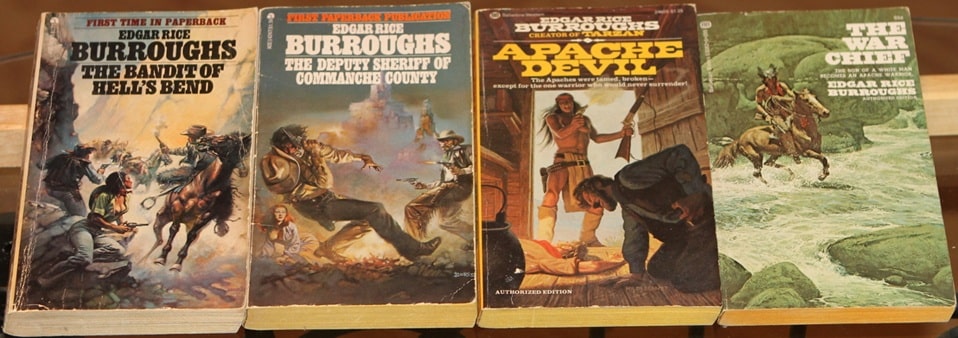 Westerns by Edgar Rice Burroughs: The Bandit of Hell’s Bend and The Deputy Sheriff of Commanche County (Ace Books); Apache Devil and The War Chief (Ballantine Books). Covers by Boris Vallejo, the Brothers Hildebrandt, and Frank McCarthy.
Westerns by Edgar Rice Burroughs: The Bandit of Hell’s Bend and The Deputy Sheriff of Commanche County (Ace Books); Apache Devil and The War Chief (Ballantine Books). Covers by Boris Vallejo, the Brothers Hildebrandt, and Frank McCarthy.
Like many pulp writers of his day, ERB dipped his toes into the western genre. He wrote four: two pretty standard ones and two that incorporate the Native American experience. He knew something of what he wrote, having worked on his brother’s ranch in Idaho at age 16, and having served with the 7th cavalry in Arizona in the late 1890s.
His first standard western was The Bandit of Hell’s Bend (1924), followed by The Deputy Sheriff of Commanche County in 1940. Both of my copies are later printings from Ace with very cool Boris illustrations. I like these better than many of Boris’s paintings because they seem less static. He does a good job of portraying action here.
In Bandit, we have a disgraced ranch foreman and a young woman who has inherited the ranch, and various villains who want to steal the ranch from her because they know there’s silver on it. The foreman, Bull, has to rise to the occasion. There’s great action and pretty good plotting, although you’ll probably figure it out pretty soon. And, as always, ERB creates sympathetic heroes and dastardly villains.
In Deputy Sheriff, a cowboy named Buck Mason is suspected of a murder he didn’t commit, and he has to run and hide until he has a chance to prove his innocence. This plot is not as good as Bandit but it gets the job done to showcase ERB’s lightning paced tale.
ERB’s other two westerns are connected and center very strongly on the Native American experience. The hero, though, is a white boy who is taken captive by Apaches and raised as Geronimo’s adopted son. He is given the Apache name of Shoz-Dijiji (Black Bear), for having killed one at a young age, and he grows up hating whites.
These books are The War Chief (1927), and Apache Devil (1933). Although there are some stereotypical elements to these books, they show that ERB had very strong sympathies for the Apache and disapproved of the way they had been treated by whites.
I found all of these books well worth reading, though the Apache books have stayed with me the longest. The cover art for The War Chief is magnificent and is by Frank McCarthy. The Apache Devil cover looks to be signed by Hildebrandt.
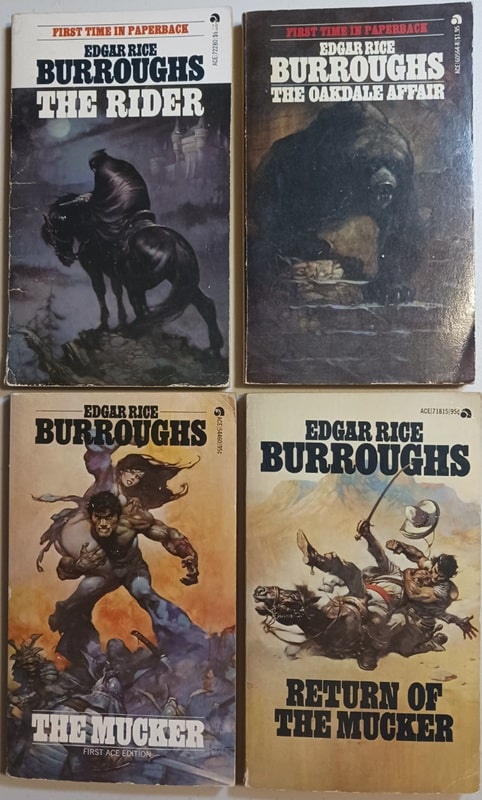 The Rider, The Oakdale Affair, The Mucker, and Return of the Mucker (Ace Books). Covers by Frank Frazetta.
The Rider, The Oakdale Affair, The Mucker, and Return of the Mucker (Ace Books). Covers by Frank Frazetta.
ERB wrote a three book series generally called The Mucker. They were first published in magazines in the mid to late 1910s, but I have much later reprints, of course, from the 1970s. All of mine, shown here, are from Ace books with Frazetta covers. I particularly like the first book cover, although all are cool.
The Mucker (1914). Billy Byrne is born on the mean streets of Chicago and grows up a criminal. After being accused of murder, he flees to San Francisco and ends up shanghaied. A shipwreck leaves him and a beautiful high society girl stranded in an east Asian jungle and she needs rescuing. I really liked the development of the character here. Through love, Billy learns how to be a decent human being and becomes quite a hero.
The Return of the Mucker (1916). This book finds Billy trying to clear himself of his previous murder charges and failing. He ends up in Mexico in the midst of a revolution. And it so happens that his love interest from the first book, Barbara, is also there. The Mucker was a very fine novel but the sequel is pretty weak. Coincidences pile upon coincidences until it’s pretty hard to suspend belief. But it still has the action rolling. This one could easily be counted as one of his westerns given the setting.
The Oakdale Affair (1918). I’m not sure what ERB was striving for with this book. It’s got mystery elements, gothic elements, horror elements, western type elements. He put everything and the kitchen sink into this one. But it worked and I enjoyed it. It is only peripherally related to the Mucker stories in that it features a hobo character that appeared in The Return of the Mucker.
I included ERB’s The Rider here because of the Frazetta cover and because it was at one point published in a double with The Oakdale Affair. But it’s not part of the Mucker series. It involves a bandit called “The Rider” who exchanges places with a prince (Boris) who is about to be married to the princess of another European duchy (neither of whom want to marry the other). Chaos ensues. ERB crammed a lot of action and plot twists into this short work.
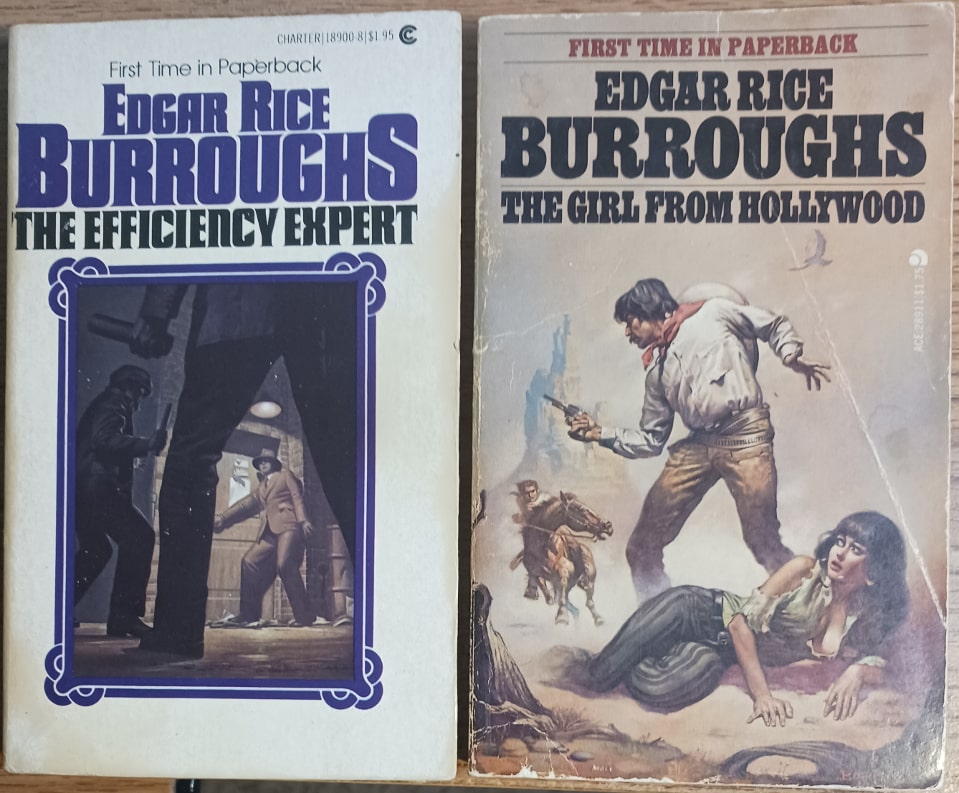 The Efficiency Expert (Charter, 1979) and The Girl From Hollywood (Ace Books, 1977). Covers by John Rush and Boris Vallejo
The Efficiency Expert (Charter, 1979) and The Girl From Hollywood (Ace Books, 1977). Covers by John Rush and Boris Vallejo
My favorite genres are Fantasy, SF, Westerns, Horror, and Thrillers. I don’t read a lot of straight mysteries and read relatively little “mundane” fiction. By mundane, I mean fiction set in a modern world where the happenings are portrayed as realistic. After reading ERB’s westerns and everything he wrote with fantastic elements, I was left with three books: The Girl from Hollywood, The Efficiency Expert, and The Girl From Farris’s.
They were also among the more difficult ERB books to find and were expensive, but I wanted them because they were… well, ERB. I got both Girl and Efficiency in 1970’s paperback form but couldn’t get Farris and finally ordered it in a modern paperback printed from public domain materials. Here are my capsule reviews.
The Girl from Hollywood (ACE, 1977, Boris Cover) is not quite a western. It takes place in the 1920s, but much is set in a western landscape and involves many western tropes. The plot involves a fine western family whose lives become entangled with Hollywood types. Some of these are basically good and recover from their evil natures while others never do.
As is typical of ERB’s work, there are coincidences that help the plot along, and there’s actually very little action compared to his typical story. However, the sheer narrative drive that ERB was able to bring to his tales keeps you reading. I finished it in one day, if not quite one sitting. Not my favorite work by him by far, but still enjoyable.
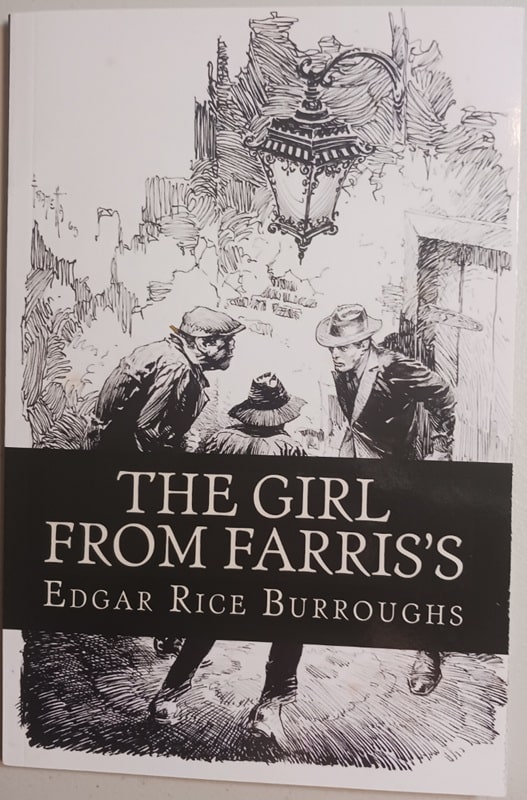 The Girl from Farris’s (CreateSpace edition, 2017). Cover by Frank Frazetta
The Girl from Farris’s (CreateSpace edition, 2017). Cover by Frank Frazetta
The Girl from Farris’s (Public Domain, from CreateSpace, 2017). The cover is by Frank Frazetta. An editorial note names Taylor Anderson as editor, and claims the publisher is Odin’s Library Classics. The text appears to be intact but the print is small and there are no indented paragraphs. I actually read this in ebook version, though, so I’ll just stick it on my shelves. I rather like the cover but don’t know where it came from.
“Farris’s” is a house of ill repute and June Lathrop a lady of the evening who is trying to escape it. She meets a young man — Ogden Secor — who wants to help her and fate keeps throwing them together. It’s a tale of redemption, which is an element in all three of these novels. One particularly interesting point is that Ogden is a failed Chicago businessman who tries to make a new life for himself in Idaho. ERB himself fled the business world of Chicago for his brother’s Idaho ranch. They say, “write what you know.”
The Efficiency Expert (Charter, 1979, cover by John Rush) is the last Burroughs book I’ve read, and very nearly the last one to exist that I hadn’t read. I left these three to last thinking they weren’t much up my alley. None of them have any fantastic elements. Efficiency Expert is a straightforward and realistically based story of a young man of quality who is down on his luck but never succumbs to corruption and wins out in the end. I was engrossed throughout. There’s certainly plenty of coincidence featured in the plot but I didn’t mind it much and even without a lot of action happening, it had narrative drive and kept my attention.
I’d rate Efficiency the best of the three, followed by Hollywood and Farris’s.
We’ll wrap up Burroughs next time with a look at his Hollow Earth tales.
Previous installments in this series include:
The Fiction of Edgar Rice Burroughs, Part I: Sword and Planet
The Fiction of Edgar Rice Burroughs, Part II: Tarzan and The Land That Time Forgot
Charles Gramlich administers The Swords & Planet League group on Facebook, where this post first appeared. His last article for Black Gate was The Fiction of Edgar Rice Burroughs, Part II: Tarzan and The Land That Time Forgot.
Comment on Worldbuilding Articles: Reader Poll (2025 Edition) by Matt
1. Essentia Capacity
2. Sigl fashion
Comment on Worldbuilding Articles: Reader Poll (2025 Edition) by Bill
1) Sigl Recycling & Essentia Storage (Aurum)
2) [Write-In] Spiritual Entities/factions & their special ‘Gifts’
3) [Write-In] Cults (like The Winged) who align to Spirits
4) [Write-In] Creating Sigl for other species (As above)

Recent comments